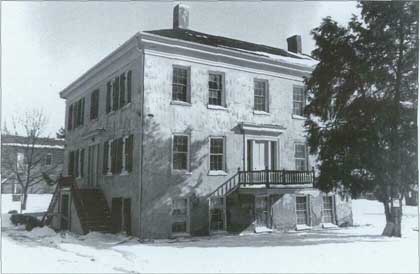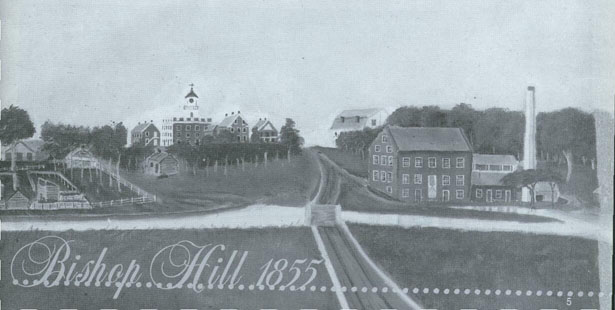• Activity 2 will allow students to exercise observation skills by noting and discussing details from folk paintings depicting everyday life at Bishop Hill.
• Activity 3 will allow students to read, analyze, and evaluate a historical document.
• Activity 4 will allow students to demonstrate creative abilities through writing and/or art projects.
• Discuss the key points of the lesson with students.
• Use the results of each activity to generate discussion.
• Allow time for students to share results of the creative activities from Handout 4 with the rest of the class.
Extending the Lesson
• Visit Bishop Hill in Henry County, Illinois
• Learn more about Bishop Hill from letters sent by colonists, reprinted in the following:
H. Arnold Barton, ed., Letters From the Promised Land: Swedes in America, 1840-1914. Minneapolis:
University of Minnesota Press,1975, 35-45, 78-83.
Lilly Setterdahl, "Emigrant Letters by Bishop Hill Colonists," Western Illinois Regional Studies 1:2 (Fall 1978), 121-75.
• A convenient summary of the founder of Bishop Hill and the colony during its lifetime, is Paul Elmen, Wheat Flour Messiah: Eric Jansson of Bishop Hill (Carbondale: Southern Illinois University Press, 1976).
• Research and report on Nauvoo or any other of the planned communities referred to in the article. Compare and contrast these findings with the experience at Bishop Hill.
Assessing the Lesson
• Discuss with students the concept of the United States as a nation of immigrants. On an informal basis, survey class members for knowledge of their own historical roots. As a class, discuss what makes someone an American.
• Have students locate and bring to class newspaper or magazine articles on immigration issues. Discuss current attitudes toward immigration; compare and contrast them with attitudes of the past.

|
 Administration Building, Bishop Hill
Administration Building, Bishop Hill
|
6

Each of the following questions are two-fold. The first part of each requires the student to recall specific information from the article, to check for understanding. The second part involves more speculative, critical thought. According to classroom needs, any or part of one or all of the questions may be used for classroom discussion. Or, if you prefer, each question may be assigned to a small group of 4 or 5 students. Each group should appoint a recorder and a spokesperson to report results to the rest of the class.
- Why did the followers of Eric Jansson leave Sweden? Historically, how do their motives compare with those of other groups that came to America?
- What kinds of things made the Swedish people picture America and Illinois as a Utopia? To what degree were these visions realized?
- Why was the colony able to prosper even after the murder of its founder Eric Jansson? Speculate as to why John Root received only a two-year prison term.
- What factors led to the eventual dissolution of the colony? Give reasons why such a community could or could not exist today.
7

Olof Krans came to Bishop Hill with his parents in 1850 when he was twelve years old. He left the colony in 1861 to become a soldier in the Civil War. Most of his works of Bishop Hill were painted in 1896 for the fiftieth anniversary of the founding of the colony. Krans painted the series from memory with the aid of friends, relatives, and photographs.
Observe details in two Krans paintings, "Cradling the Grain" and "Women in a Row." Answer the questions that follow.
- What are the men doing in each painting?
- What are the women doing in each painting?
- What factors do you suppose determined the different kinds of tasks men and women performed at Bishop Hill?
- What other kinds of tasks might have been assigned to men? To women? To children? To the elderly?
- Of what value might these paintings be to historians interested in learning about everyday life at Bishop Hill?
8

The following is an excerpt from a letter written by Lars Ersson, who emigrated to Bishop Hill with his wife and daughter in 1854. Read the letter, then answer the questions that follow.
Bishop Hill, May 21, 1855
Beloved brother Anders Mattson:
All we have to do is work quietly, each one in his call of duty and listen to our teachers preaching. We let the words rankle in our minds until they start to grow and bear fruit in our hearts. We do not have to worry about either clothing or food. We just go to the kitchen and eat. It was not like that in Sweden. We have breakfast with coffee as soon as we are dressed, dinner at twelve noon, supper with coffee around 4:00 P.M., and the evening meal at 6:00 P. M. The food is fresh and tasty. We always have wheat bread. As for clothes, we get garments as needed. The tailor and the shoemaker work in their shops as fast as they can, so there is no shortage of wearing apparel.
We have a steam mill which is famous in the area. It grinds and sifts about 100 Swedish tunnor [barrels] in twenty-four hours. It is keeping the whole colony in bread. When there is no milling, the same steam engine is powering a saw. With God's blessing the colony has now become prosperous. We have about 1,000 hogs which are nice and fat. We keep them in a small meadow and feed them bran, oats, and corn. The soil is good and yields more than in Sweden. For the most part it is like the finest cabbage bed. The top soil is four to six quarter [about three feet] deep. The forest is like a paradise, with green leaf trees, grass, and flowers of all kinds making it a pretty place.
Last year several brick buildings were built. This year more houses have gone up and more will be built. It will be a strange but rather beautiful town when it is ready... My daughter Johanna goes to school to learn English like everyone else her age...
9

- Is this letter a primary or secondary source?
- How do you know?
- For a newly arrived Swedish immigrant, what might be some advantages of living in a planned colony?
- How might needs change as the immigrants' children became fluent in English?
- Suppose you are a historian writing about life at Bishop Hill. Would Lars Ersson's letter be of any value to you? Why or why not?
10

The following activities may be done individually or in pairs. Read and then discuss examples and possibilities for each before allowing students to begin.
- Using key words and drawings, create a poster advertising life at Bishop Hill. Your purpose should be to urge friends and relatives to join the colony.
- Pretend you are one of the followers who arrived at New York City with Jansson in June 1846. Write a letter home to relatives in Sweden accounting for the inaccuracies of Jansson's fantastic predictions. Be sure to mention why you did or did not leave the group.
- Write an essay comparing and contrasting modern farming methods with those of Bishop Hill, as depicted in the two Krans paintings. You may want to confine your discussion to a specific activity, such as planting corn or harvesting wheat, rather than try to cover all areas.
- The paintings of Olof Krans depict a bygone way of life. Draw a picture detailing a simple, everyday activity from your neighborhood or school. Include details in clothing, tools, architecture, or customs that may be of value to historians one hundred years from now. Be prepared to theorize why the objects depicted in your drawing may become obsolete.

Click Here to return to the Article
11


